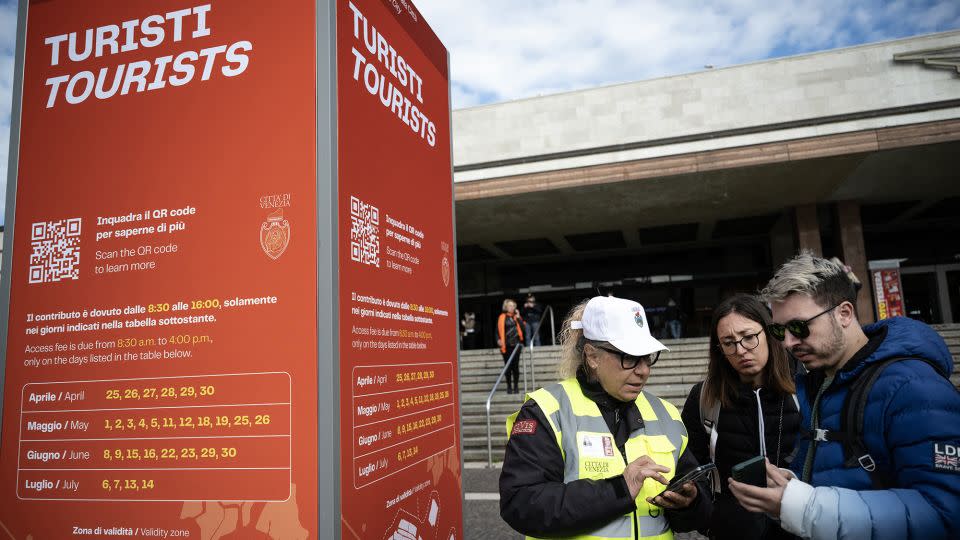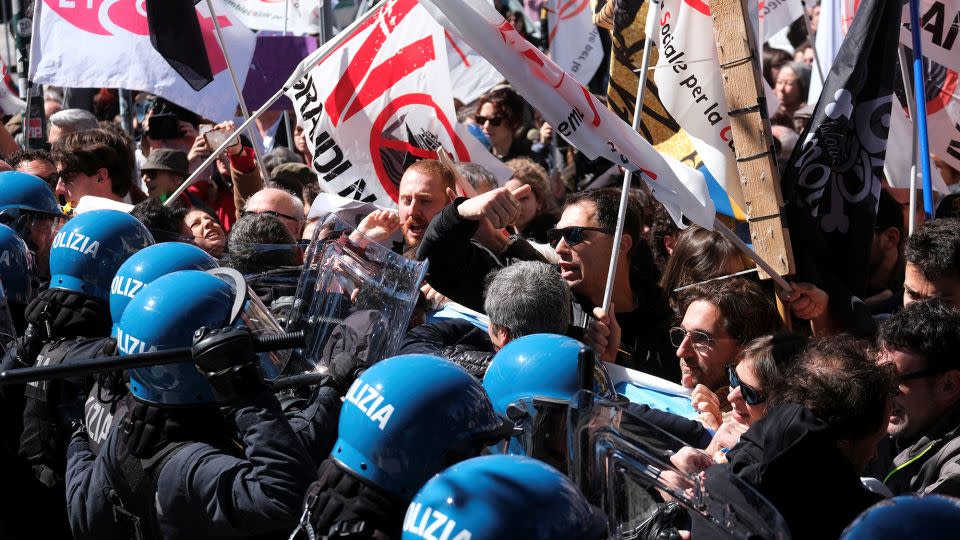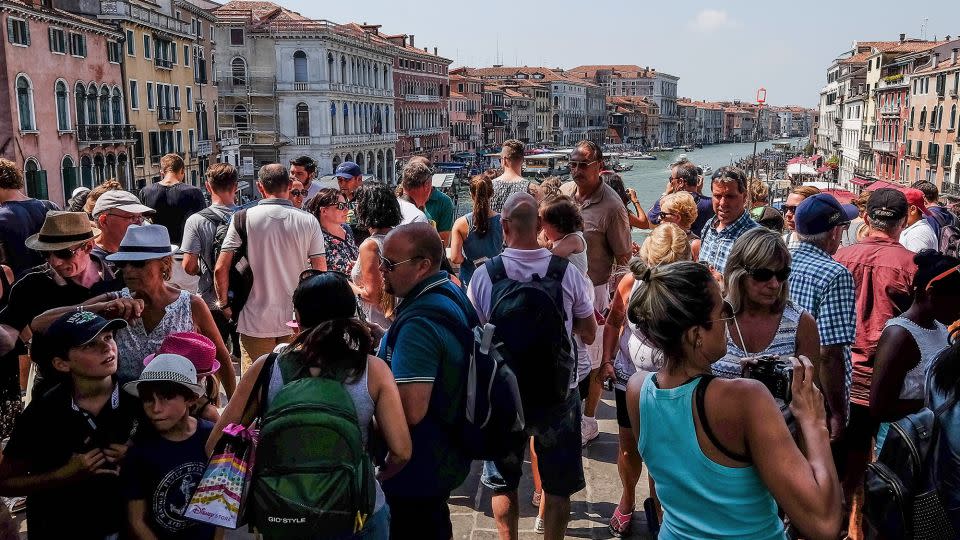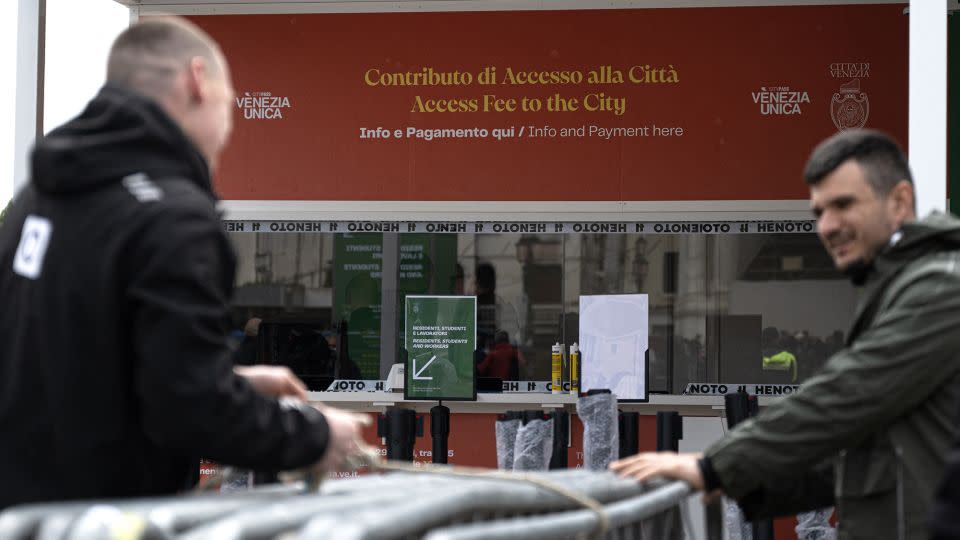Protests as Venice begins charging entry fee for day-trippers
April 25 has long been a historic day in Venice – the date is not just Italy’s Liberation day, but it’s also the feast day of the city’s patron saint, St. Mark.
But now Venice will notch up another dose of history for April 25 – as the day the city becomes the first in the world to charge day-trippers an entry fee.
There were protests as the day got underway with locals waving banners and holding up their passports in anger at the city being put behind a barrier in the style of a theme park or museum. Photos show police clashing with some protesters.
The long-awaited contributo di accesso (it’s styled as an ‘access contribution’ rather than a ticket) started at 8.a.m. on Thursday. The city council is running a pilot project until mid July to see if it can make the system work.

Anybody visiting Venice as a tourist for the day – except those who live in the local Veneto region – must pay the 5 euro ($5.40) charge if they arrive between 8 a.m. and 4 p.m..
Tourists staying overnight don’t have to pay, as an overnight tax is already added to their accommodation bills. However they too will have to register their presence to request an exemption to the fee. Essentially, anyone entering the city on dates the fee is charged must carry either a ticket or an exemption. The only exceptions are residents of Venice and people who were born there.

Hundreds of locals participated in a protest at Piazzale Roma, the entry point by road to the city, though the exact number was disputed. Protestors say that at its largest the group was 1,000 strong, while the authorities said that only 300 attended.
A smaller protest took place near the main train station with Venetians confronting the mayor who was giving interviews to various television crews. That protest ended up in an embrace with the mayor, according to news reports which captured the confrontation.
Ruggero Tallon, one of the main protest organizers and the spokesperson for anti-cruise ship campaign group No Grandi Navi, told CNN that the group had planned to erect a banner spelling out “Welcome to Veniceland” and hand out fake “tickets” to passersby, but were stopped by police. Instead they marched to Campo Santa Margherita, one of the city’s main squares.
“We rose up against the mayor’s idea of a closed city, a museum city,” Tallon told CNN.
“A ticket does nothing. It doesn’t stop the monoculture of tourism. It doesn’t ease the pressure on Venice. It’s a medieval tax and it’s against freedom of movement.”
He expressed concern that the project is being managed by a private company, which will receive people’s data, and suggested that other moves by the authorities – including angling for the return of cruise ships to the lagoon, and not yet restricting Airbnbs – are adding to the problem.
“With the one hand they are doing this, with the other they are doing everything to increase the number of tourists,” said Tallon, who called mass tourism a “global problem.”
“The only way [forward] is to repopulate the city – we have 49,000 inhabitants and there are more beds for tourists than residents,” he said. “Let’s try to make it possible for people to live here. Every house that’s lived in is a house taken away from tourism.”
Elena Gastaldello, president of Arci (Italian recreational and cultural association) of Veneto, who took part in the protest, said that the entrance fee will not control numbers.
“The ticket will not impose limits on tourist access to Venice as no maximum number of visitors has been established, but it will further transform the city into an amusement park,” she told CNN by phone.
“This measure is not accompanied by concrete policies for urban development, rent containment and ease of finding housing. It solves no problems.”
A spokesperson for the mayor’s office told CNN that 113,000 visitors registered for the first day, with about 80,000 doing so in advance. Of that number, 15,700 – a little over 10% – paid the fee.
Of the exemptions, almost 40,000 were hotel guests, and around 4,000 were friends or family of residents. Over 20,000 commuters and 13,000 students entered the city. School groups were also counted.
The council said that they inspected the credentials of nearly 14,000 people.
‘It’s laughable’

The registration scheme has spotlit the housing problems for residents – on the first day alone, 5,300 people had registered to enter the city as second home owners. Venetian residents now number less than 50,000, with tens of thousands squeezed out of the city to make room for second homes and Airbnbs.
In preparation for the first day, the council spent the past few days setting up checkpoints outside the train and bus terminals, with separate lines for “residents” and “tourists.” There is also a booth outside the train station for arrivals to pay the fee or register an exemption. Around 150 people have been employed to verify people’s documents and provide advice.
The fee will be charged on 29 days between now and July 14. After that, mayor of Venice Luigi Brugnaro has said that they will review how the pilot project has gone before they decide how to continue.
“Nobody has ever done anything to regulate tourism and we believed it was necessary to do something,” he said in a statement on the first day of the project.

The fee has proved controversial with Venetians who fear that it risks turning the city into a theme park, and dislike the idea of having to register any guests.
As some locals geared up to protest the introduction of the fee, fully booked trains were pouring into the city from Milan and Rome.
The first tourists to be faced with the checkpoints on entering the city seemed unfazed.
“I think it’s a good thing – it wouldn’t deter me,” said Dominic Gagliano, a regular Italy visitor from from Scottsdale, Arizona, as he got off a train at Santa Lucia station.
“I went to Cinque Terre last fall and it was just impossible. And we just came from Verona – I was last there in 2015 and it has changed so much. I think if you want to come to Venice, you’re going to pay 5 euros to be here.”
Gagliano, who had booked an Airbnb, said that the host had sent the link to apply for an exemption. The process was fairly smooth, he said – other than having to phone an Italian number to get confirmation. “I don’t understand why they didn’t just have an email confirmation,” he said.
Caroline Butler, from Wilmington, North Carolina, was also in favor of the move.
“I went to Florence for the fifth time recently and I had to get out – the crowds were so thick,” she said. “It was like July.”
Canadians Denise Gomes and Brian Johnson from Ottawa said they had been keeping track of when the fee would be introduced, having heard about it in the news back home. Their hotel hadn’t informed them.
“I’m in favor of it – my assumption is it’s going to help pay for infrastructure to allow others to see Venice,” she said.
For Johnson, it’s important that visitors contribute to the destinations they travel to.
“People go on a cruise and don’t spend a penny, but someone’s got to pay,” he said.
“We always try to inject money into the local economy,” said Gomes. “It’s really important.”
Locals, however, remained skeptical. Paolo Brandolisio, who makes oars and forcole (Venice’s famous rowlocks for gondolas) told CNN that he doesn’t think the fee will help the city under siege from overtourism.
“They’re not putting an upper limit for entry, and today 80,000 people have booked – it’ll be a nightmare,” he said.
“What happens if 150,000 people book and they have to let them in? They say that people’s freedom must be respected, but that they must pay. It’s laughable.”
He suggested incentivizing visitors to stay longer, by offering discounts for longer hotels, for example – or simply limiting visitor numbers. Prioritizing life for locals was ultimately more important to preserve Venice, he added.
Achille Giacom, who was staging a one-man protest outside the train station throughout the afternoon, said that he was concerned about handing over data.
“It’s a measure of control on the population,” he said. “Data is just another resource. [Mankind] has used up the planet’s natural reserves and human reserves, and now it wants our data.
“Italians are usually the first to disobey, but with this it’s like they’re hypnotized.”
Barbie Latza Nadeau in Rome contributed to this story
For more CNN news and newsletters create an account at CNN.com

 Yahoo Sports
Yahoo Sports 